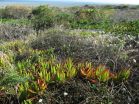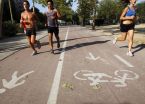(Press-News.org) PROVIDENCE, R.I. [Brown University] — Dov Sax of Brown University and Jason Fridley of Syracuse University aren't proposing a novel idea to explain species invasiveness. In fact, Charles Darwin articulated it first. What's new about Sax and Fridley's "Evolutionary Imbalance Hypothesis" (EIH) is that they've tested it using quantifiable evidence and report in Global Ecology and Biogeography that the EIH works well.
The EIH idea is this: Species from regions with deep and diverse evolutionary histories are more likely to become successful invaders in regions with less deep, less diverse evolutionary histories. To predict the probability of invasiveness, ecologists can quantify the imbalance between the evolutionary histories of "donor" and "recipient" regions as Sax and Fridley demonstrate in several examples.
Darwin's original insight was that the more challenges a region's species have faced in their evolution, the more robust they'll be in new environments.
"As natural selection acts by competition, it adapts the inhabitants of each country only in relation to the degree of perfection of their associates," Darwin wrote in 1859. Better tested species, such as those from larger regions, he reasoned, have "consequently been advanced through natural selection and competition to a higher stage of perfection or dominating power."
To Sax and Fridley the explanatory power of EIH suggests that when analyzing invasiveness, ecologists should add historical evolutionary imbalance to the other factors they consider.
"Invasion biology is well-studied now, but this is never listed there even though Darwin basically spelled it out," said Sax, associate of ecology and evolutionary biology. "It certainly hasn't been tested before. We think this is a really important part of the story."
Evidence for EIH
Advancing Darwin's insight from idea to hypothesis required determining a way to test it against measurable evidence. The ideal data would encapsulate a region's population size and diversity, relative environmental stability and habitat age, and the intensity of competition. Sax and Fridley found a suitable proxy: "phylogenetic diversity" (PD), an index of how many unique lineages have developed in a region over the time of their evolution.
"All else equal, our expectation is that biotas represented by lineages of greater number or longer evolutionary history should be more likely to have produced a more optimal solution to a given environmental problem, and it is this regional disparity, approximated by PD, that allows predictions of global invasion patterns," they wrote.
With a candidate measure, they put EIH to the test.
Using detailed databases on plant species in 35 regions of the world, they looked at the relative success of those species' invasiveness in three well-documented destinations: Eastern North America, the Czech Republic, and New Zealand.
They found that in all three regions, the higher the PD of a species' native region, the more likely it was to become invasive in its new home. The size of the effect varied among the three regions, which have different evolutionary histories, but it was statistically clear that plants forged in rough neighborhoods were better able to bully their way into a new region than those from evolutionarily more "naive" areas.
Sax and Fridley conducted another test of the EIH in animals by looking at cases where marine animals were suddenly able to mix after they became united by canals. The EIH predicts that an imbalance of evolutionary robustness between the sides, would allow a species-rich region to dominate a less diverse one on the other side of the canal by even more than a mere random mixing would suggest.
The idea has a paleontological precedent. When the Bering land bridge became the Bering Strait, it offered marine mollusks a new polar path between the Atlantic and Pacific Oceans. Previous research has shown that more kinds of mollusks successfully migrated from the diverse Pacific to the less diverse Atlantic than vice-versa, and by more so than by their relative abundance.
In the new paper, Sax and Fridley examined what has happened since the openings of the Suez Canal in Egypt, the Erie Canal in New York, and the Panama Canal. The vastly greater evolutionary diversity in the Red Sea and Indian Ocean compared to the Mediterranean Sea and the Atlantic led to an overwhelming flow of species north through the Suez.
But evolutionary imbalances across the Erie and Panama Canals were fairly small (the Panama canal connects freshwater drainages of the Atlantic and Pacific that were much more ecologically similar than the oceans) so as EIH again predicts, there was a more even balance of cross-canal species invasions.
Applicable predictions
Sax and Fridley acknowledge in the paper that the EIH does not singlehandedly predict the success of individual species in specific invasions. Instead it allows for ecosystem managers to assess a relative invasiveness risk based on the evolutionary history of their ecosystem and that of other regions. Take, for instance, a wildlife official in a historically isolated ecosystem such as an island.
"They already know to be worried, but this would suggest they should be more worried about imports from some parts of the world than others," Sax said.
Not all invasions are bad, Sax noted. Newcomers can provide some ecosystem services — such as erosion control — more capably if they can become established. The EIH can help in assessments of whether a new wave of potential invasion is likely to change the way an ecosystem will provide its services, for better or worse.
"It might help to explain why non-natives in some cases might improve ecosystem functioning," Sax said.
But perhaps Darwin already knew all that.
INFORMATION: END
On invasive species, Darwin had it right all along, study shows
2014-10-02
ELSE PRESS RELEASES FROM THIS DATE:
Twice the DNA yield in less time
2014-10-02
Molecular studies of plants often depend on high-quantity and high-quality DNA extractions. This can be quite difficult in plants, however, due to a diversity of compounds and physical properties found in plants. "Tannins, tough fibrous material, and/or secondary compounds can interfere with DNA isolation," explains Dr. Thomas Givnish, principal investigator of a new study published by Jackson Moeller et al. in the October issue of Applications in Plant Sciences (available for free viewing at http://www.bioone.org/doi/pdf/10.3732/apps.1400048).
This is further complicated ...
A new approach to on-chip quantum computing
2014-10-02
WASHINGTON, Oct. 2, 2014—Commercial devices capable of encrypting information in unbreakable codes exist today, thanks to recent quantum optics advances, especially the generation of photon pairs—tiny entangled particles of light. Now, an international team of researchers led by professor Roberto Morandotti of INRS-EMT in Canada, is introducing a new method to achieve a different type of photon pair source that fits into the tiny space of a computer chip.
The team's method, which generates "mixed up" photon pairs from devices that are less than one square millimeter ...
Making old lungs look young again
2014-10-02
VIDEO:
A new study suggests ibuprofen can make old lungs look young. In lab tests, daily ibuprofen lowered lung inflammation in elderly mice. The research and its implications are described by...
Click here for more information.
COLUMBUS, Ohio – New research shows that the lungs become more inflammatory with age and that ibuprofen can lower that inflammation.
In fact, immune cells from old mouse lungs fought tuberculosis bacteria as effectively as cells from young mice after ...
Grandparents' support linked to parents' willingness to have children and child welfare
2014-10-02
Grandparents can significantly influence parents' decisions to have additional children and the well-being of grandchildren, according to a recent study completed at the University of Eastern Finland.
In his PhD study, Dr Antti O. Tanskanen observed that grandparents' help with childcare and emotional support are linked to mothers' willingness to have a second or a third child. Furthermore, parents of small children who obtain support from paternal grandparents are also more likely to have additional children. The involvement of maternal grandparents in the lives of their ...
Common painkillers combined with other drugs may cause high risk of GI bleeding
2014-10-02
Bethesda, MD (Oct. 2, 2014) — Nonsteroidal anti-inflammatory drugs (NSAIDs) — such as ibuprofen and aspirin — increase one's risk of upper gastrointestinal bleeding. When taken in combination with other drugs, this risk is significantly higher, according to new research appearing in the October issue of Gastroenterology, the official journal of the American Gastroenterological Association.
"These findings may help clinicians tailor therapy to minimize upper gastrointestinal bleeding, and are especially valuable in elderly patients who are likely to use multiple drugs ...
Dog's epigenome gives clues to human cancer
2014-10-02
The bond between humans and dogs is strong and ancient. From being the protector of the first herds in a faithful pet, dogs and people share many aspects of life. The relationship between the two species has been studied by psychologists, anthropologists, ethnologists and also by genetic and molecular biologists. In this sense, dogs are a great model for understanding the causes of human diseases, especially cancer.
Unlike other mammals used in research, dogs develop cancer spontaneously as humans do and cancer is the most common cause of death in this species. The dog ...
Horizon Report urges schools to tackle 'wicked' digital skills challenge
2014-10-02
This news release is available in French, Spanish and German.
Low digital skills and competences among school pupils and the need to integrate effective use of information and communication technologies into teacher training are among the most pressing challenges faced by European school education today, according to a report published by the European Commission and the New Media Consortium, a US-based not-for-profit body bringing together experts in education technology. The first-ever Horizon Report Europe: 2014 Schools edition outlines the trends and technological ...
Energy drinks cause insomnia and nervousness in athletes
2014-10-02
A study analysing the positive and negative effects of energy drinks on athletes has seen that, although in principle their sports performance was seen to improve by between 3% and 7%, there was also an increase in the frequency of insomnia, nervousness and the level of stimulation in the hours following competition.
The consumption of energy drinks has increased in recent years. In the case of athletes, the use of them before practising sport has also risen: more than 50% take them during training and even before competitions.
A four-year study carried out by experts ...
Drug-food interactions in mountaineering
2014-10-02
This news release is available in Spanish. According to a recent paper published by the researchers Aritz Urdampilleta-Otegui, PhD in Physical Education and Sports and lecturer in the Department of Physical and Sports Education of the UPV/EHU-University of the Basque Country and at the Government of the Basque Autonomous Community (region), and Saioa Gómez-Zorita, PhD in Pharmacy and Food Sciences and researcher at the UPV/EHU's Department of Pharmacy and Food Sciences, it is necessary to control the administering of drugs that interact with the foods consumed and which ...
Auditory system: The ruffling effect of rumble
2014-10-02
Barely perceptible low-frequency signals nevertheless activate measurable responses in our auditory circuits. Neurobiologists at Ludwig-Maximilians-Universitaet (LMU) in Munich have now characterized the remarkable impact of low-frequency sounds on the inner ear.
The human auditory system appears to be poorly adapted to the perception of low-frequency sound waves, as hearing thresholds become markedly higher for frequencies lower than about 250 Hz. Yet sensory cells do react to pressure waves with frequencies below 100 Hz, as revealed by the fact that such signals actually ...





